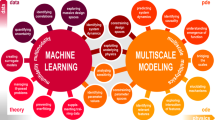Abstract
A nonlinear ordinary differential equation model of time-dependent features of six macroscopic molecular groups on information and function interacting in living beings (Naitoh in Jpn J Ind Appl Math 28:15–26, 2011; Naitoh and Inoue in J Artif Life Robot 18:127–132, 2013) brings a possibility for predicting the morphogenetic process and sustainment of human beings. In this report, along with the number theory, we derive mathematical conditions for predicting the premonition just before sickness, which are logically derived from the differential equation model, and also agree with computational results of death and apparent death obtained by numerically solving the equation model. The mathematical conditions derived agree with an important knowledge revealed by Chen (Proceedings of the international symposium on artificial life and robotics (AROB20th), Beppu, Oita Japan, pp 127–132, 2015), i.e., a critical condition on densities of healthy molecules just before sickness. This agreement is an evidence for significance of our nonlinear equation model and the linear analysis done by Chen et al. Furthermore, we also derive a two-step mathematical condition for classifying death and apparent death. These conditions lead to a method for acquiring premonition of illness and a method for recovering from illness. Finally, we show a possibility that this equation model, extended with random noise from environmental disturbance, may predict life pattern concerning periods of sickness, while also considering polymorphism.










Similar content being viewed by others
References
Naitoh K, Inoue H (2013) Catastrophic chaos theory: predicting recovery of health or death. J Artif Life Robot 18:127–132 [Also as Naitoh K, Inoue H (2013) Catastrophic chaos theory: predicting recovery of health or death. Proceedings of the International Symposium on Artificial Life and Robotics (AROB18th), Beppu, Oita Japan, Jan 30–Feb 1, 2013]
Naitoh K (2011) Morphogenetic economics: seven-beat cycles common to durable goods and stem cells. Jpn J Ind Appl Math 28:15–26
Takashima H, Saiki M, Naitoh K (2015) Prognostic medicine based on six molecular group equations. In: Proceedings of the international symposium on artificial life and robotics (AROB20th), Beppu, Oita Japan, Jan 21–23, 2015, pp 581–584
Yamanaka S, Nakauchi H (2012) Stem cell (in Japanese). Asakura-shoten 79
Banasik M, Komura H, Shimoyama M, Ueda K (1992) Specific inhibitors of poly(ADP-ribose) synthetase and mono(ADP-ribosyl) transferase. J Biol Chem 267(3):1569–1575
Konagaya R, Naitoh K (2016) Prognostic medication: for predicting premonition, recovery, lifespan, life pattern, and polymorphism. In: Proceedings of the international symposium on BioComplexity (ISBC 1st), Beppu, Oita Japan, Jan 20–22, 2016
Konagaya R, Naitoh K (2015) Prediction of death and apparent death: mathematical conditions derived from the six equation model. Extended abstract of JSST annual conference, Toyama, Japan, October 12–14, 2015
Chen L (2015) Dynamical network biomarkers for identifying early-warning signals of complex diseases. In: Proceedings of the international symposium on artificial life and robotics (AROB20th), Beppu, Oita Japan, Jan 21–23, 2015, pp 127–132
Nakamura Y, Gojobori T, Ikemura T (2000) Nucleic Acids Res 28:292. http://www.kazusa.or.jp/codon/
Lowe TM, Eddy SR (1995) Nucleic Acids Res 25:955. http://rna.wustl.edu/tRNAdb/
Ashburner M et al (2000) Gene ontology: tool for the unification of biology. Nat Genet 25:25–29
Kuriyama S, Yaegashi N, Nagami F et al (2016) The Tohoku Medical Megabank Project: design and Mission. J Epidemiol. doi:10.2188/jea.JE20150268
Mullis KB (1990) The unusual origin of the polymerase chain reactions. Sci Am 262:56–65
Naitoh K (2011) Onto-neurology. In: Proceedings of JSST 2011 international conference on modeling and simulation technology, pp 322–327 (also Naitoh K (2015) patent. Submitted)
Naitoh K (2010) Onto-biology. J Artif Life Robot 15:117–127
Naitoh K (2012) Spatiotemporal structure: common to subatomic systems, biological processes, and economic cycles. J Phys CS 344:1–18
Naitoh K, Ryu K, Tanaka S, Matsushita S, Kurihara M, Marui M (2012) Weakly-stochastic Navier–Stokes equation and shocktube experiments: revealing the Reynolds’ mystery in pipe flows, AIAApaper 2012-2689
Naitoh K, Shimiya H (2011) Stochastic determinism for capturing the transition point from laminar flow to turbulence. Jpn J Ind Appl Math 28:3–14
Acknowledgements
This article is part of the outcome of research performed under a Waseda university Grant for special research project (2015, 2016).
Author information
Authors and Affiliations
Corresponding author
Appendices
Appendix 1
1.1 Influence of random noise on lifespan
Stochastic differential equations including random noise, which are shown in our previous reports [14, 15], can be discretized in time by numerical methods having higher-order of accuracy over 2nd order, to reduce numerical disturbances. Thus, terms of random noise in the equations can be calculated using random number generators in computers. Magnitude of the random noises should be evaluated basically by actual noise data, which should be measured from actual patients and obtained many times per year, over a certain period of time. Other theoretical evaluation may also be included, which comes from statistical vagueness (statistical indeterminacy) related to relatively smaller number of molecules in molecular group than that for continuum mechanics (deterministic model) [16,17,18]. Further studies are necessary to validate the model on lifespans.
Appendix 2
2.1 Lifespan
Life patterns and lifespans may be predictable without exact identification of \(\alpha_{21} ,\) if the pattern of illness until a certain age is known (for example, until 50 years, as shown in Figs. 9, 10), because \(\alpha_{ij}\) can be determined by the pattern. There are two types of possibilities. The first is based on the life patterns shown in Figs. 4, 5 and 6, which directly predict the timing of death, whereas the second is based on the life pattern shown in Fig. 9. Some computational results such as that of Fig. 9 indicate periodic illness which suddenly occurs very frequently after a certain age.
It is stressed that the life pattern shown in Fig. 10 is very close to the data of an actual person, in which illness occurred at about 25, 33, 50, and 75 years, and also had a lifespan of about 80 years.
About this article
Cite this article
Konagaya, R., Naitoh, K., Suzuki, K. et al. Prognostic medication: for predicting premonition and recovery. Artif Life Robotics 22, 449–456 (2017). https://doi.org/10.1007/s10015-017-0375-0
Received:
Accepted:
Published:
Issue Date:
DOI: https://doi.org/10.1007/s10015-017-0375-0




